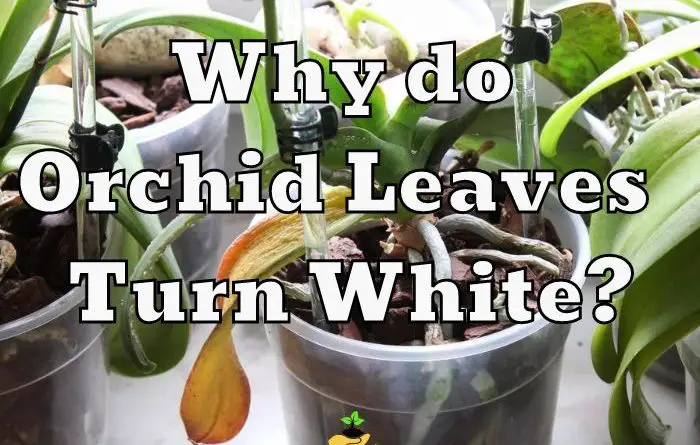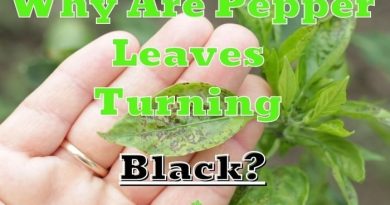Orchid Leaves Turning White? [Here’s How to Fix It!]
Very often white spots appear on orchid leaves. Today we will learn why orchid leaves are turning white and learn how to deal with them.
Orchid leaves turning white are caused by fungal infections like powdery mildew, sunburn, low humidity, or mealybugs. Powdery mildew appears as a white coating, while sunburn and low humidity can bleach the leaves. To address these issues, treat fungal infections with orchid-specific fungicides, provide shade to protect from sunburn, maintain optimal humidity levels, and ensure proper nutrient supply. Regular care and attention will help keep your orchids healthy and vibrant.
| Reasons Orchid Leaves are Turning White |
|---|
| 1. Powdery mildew |
| 2. Mealybugs |
| 3. Sunburn |
| 4. Low Humidity |
| 5. Improper soil |
Causes Why Orchid Leaves Are Turning White
1. Powdery mildew
The main cause why orchid leaves are turning white is given by a fungal disease known as powdery mildew. This disease manifests itself in the form of a loose white coating on orchid leaves and buds, sometimes on a stem or peduncle.
Powdery mildew occurs due to excessively high temperatures or waterlogging of the flower. Most often, the lower leaves are affected, after which the disease passes to the roots and stem, eating away and drying it out from the inside.
The following factors contribute to the development of powdery mildew on orchid leaves:
- Excessive fertilizer
- Incorrect watering
- The humidity is too high
- Intense changes in temperature
The pathogenic fungus is more likely to spread to already weakened plants. If orchid leaves develop white spots that resemble powdery mildew, the infected orchid must be isolated from other orchids .
How to treat Powdery mildew
| Treatment Options for Powdery Mildew | How to Treat |
|---|---|
| Neem Oil | Apply neem oil solution to affected leaves, following the product instructions carefully. |
| Fungicidal Spray | Use a recommended fungicidal spray specifically formulated for orchids to control the fungus. |
| Baking Soda Solution | Mix 1 tablespoon of baking soda in 1 gallon of water and spray the solution on the leaves. |
| Horticultural Oil | Apply horticultural oil to smother the powdery mildew spores, following product guidelines. |
| Sulfur-Based Products | Use sulfur-based fungicides according to the manufacturer’s instructions for best results. |
In this case, treatment with sulfur-based fungicide or other fungicides containing sulfur compounds should be started immediately to help cure the orchid.
At the first sign of powdery mildew infection, it is recommended to water the orchid flower well and after 2 hours spray it with a solution of sulfur-based fungicide. Leaf treatment should be repeated 3-4 times per day for 10 consecutive days.
2. Mealybugs
Even if powdery mildew is the first thing that comes to mind when there is a white coating on the leaves, the orchids are infested with mealybugs.
Mealybugs are small insects 3-6 mm in size that are common pests found on orchids leaves that feed by sucking the plant juice and producing specific white secretions on the orchids leaves called honeydew .
These pests live on the underside of your orchid leaves and the first sign of their appearance is sticky drops and a cottony white coating on both sides of the leaves.
The white spots, reminiscent of cotton wool and covering leaves, stems and buds, can be very damaging to the orchid plant. Mealybugs are very small and hard to see, so just by showing the white fur is a massive infestation.
The result is discolored, white leaves that fall off. If such an infestation is discovered, action must be taken immediately, otherwise the pests will also spread to the other surrounding plants.
How to treat Mealybugs
The affected orchid must therefore first be separated from the other plants. If the orchids are not completely covered with parasites, clean what you can with cotton swabs soaked in rubbing or 90° alcohol.
Mealybugs care be treated as follows:
- Use a cotton pad or toothbrush
- Rub isopropyl alcohol on the contaminated leaves.
- Make sure you apply alcohol to all parts of the leaf, as mealybugs tend to hide in small crevices.
- After that quickly check the other leaves, the roots, and the pot to ensure your orchid no longer has this problem.
Carry out two to three consecutive treatments, spaced 5 days apart, to eradicate the adults mealybugs as well as the larvae which hatch gradually.
You must use specific ‘anti-mealybug’ spray insecticide and respect the spray distance indicated on the packaging.
3. Sunburn
White leaves also occur from prolonged exposure to the sun and high room temperatures, which lead to burns in the orchid’s foliage. In spring and summer, ultraviolet light is particularly harmful.
Basically, when the orchid gets a lot of sun it causes overheating, leading to the appearance of white spots on the orchid leaves. These white spots after a few days turn black.
How to treat Sunburn
The recommended thing in this case is that you move your orchid and place it where it receives intense but indirect sunlight. The flower thrives best on a windowsill with diffused light. Also make sure that white damaged leaves are removed.
| Orchid Variety | Sunlight Requirement | Minimum Hours of Sunlight |
|---|---|---|
| Phalaenopsis Orchids | Indirect, bright light | 4-6 hours of filtered or indirect sunlight |
| Cattleya Orchids | Bright, filtered light | 4-6 hours of bright, filtered sunlight |
| Dendrobium Orchids | Bright, indirect light | 4-6 hours of bright, indirect light |
| Oncidium Orchids | Moderate to bright light | 6-8 hours of moderate to bright, filtered sunlight |
| Paphiopedilum Orchids | Moderate, indirect light | 4-6 hours of moderate, indirect light |
| Vanda Orchids | Bright, direct light | 6-8 hours of bright, direct sunlight (morning or late afternoon) |
4. Low humidity
Low humidity combined with lack of water will cause the root system to dry out, thus the orchid leaves will turn white. If the orchids roots have changed their color, then the orchid really needed moisture. If there is not enough moisture, the roots will turn pale and wrinkle.
Such a symptom should make it clear that the irrigation system should be adjusted and the air humidity increased immediately.
| Orchid Variety | Humidity Requirement |
|---|---|
| Phalaenopsis Orchids | 40-60% humidity |
| Cattleya Orchids | 50-70% humidity |
| Dendrobium Orchids | 50-70% humidity |
| Oncidium Orchids | 50-70% humidity |
| Paphiopedilum Orchids | 40-60% humidity |
| Vanda Orchids | 60-80% humidity |
How to treat Low humidity
It is necessary to get into the habit of watering them abundantly, ideally by immersing the pot in lukewarm water for 10 to 15 minutes, even half an hour, then allowing any excess water to drain well.
At the same time, it is important to ensure that the tips of the leaves are not immersed in water, because as a result, white oval spots with a hole in the middle may form on them.
Depending on your conditions, the orchid might need watering from once a week to once every 10 days. In summer you can increase the frequency of watering. Always make sure that the orchid soil is moist.
In this way, the orchid root system will be completely moistened and will be able to supply moisture to the leaves for a long period of time.
5. Improper soil
Often, improper soil conditions causes the formation of white spots on the leaves of orchids. The color of the orchid leaves depends on the soil composition.
A dense or poor-quality substrate disrupts the supply of oxygen to the roots and, as a result, creates conditions for the development of fungi.
You can not reuse the substrate from under the infected bushes. Such soil must be disposed of, since the infection through the soil can spread to a healthy orchid.
Therefore, experienced gardeners strongly recommend purchasing a substrate for planting orchids in trusted flower shops.
How to treat Improper Soil
Every two to three years, the orchid needs to be transplanted into a new substrate, as the old one decomposes, loses its properties, and becomes an excellent environment for the development of fungal diseases.
To disinfect the orchid bark, fry the soil substrate for 15-20 minutes in an oven at a temperature of 60 °C. This will get rid of possible pests and bacteria.
How to prevent orchid leaves from turning white
- Provide the orchid with proper watering. It will be necessary to moisten the soil again only after 2-3 days, during which it will remain dry.
- Use environmental humidifiers if necessary, if the environment is too dry.
- Promptly remove all parts of the substrate, bark fragments or other, which are moldy or rotten.
- The orchid should be lit 10-12 hours a day. Light must be diffused.
- Fertilize your orchid a couple of times a month.
- Choose good soils containing tree bark, moss, peat and river sand. Provide a good layer of drainage.
Conclusion
Orchid leaves turning white is definitely an alert that something is wrong with the orchid. Follow the indication we have provided and you will avoid the loss of the orchid and restore it’s foliage color in no time.
How to know if my orchid is dying?
Once the orchid is watered, look at its roots. If they are completely white and dry, it is likely that your plant has died and its recovery is not possible. If, on the other hand, you see roots that are green again, at least at the tips, it means that the orchid still has life and strength to recover.
Mix a teaspoon of liquid black soap, a teaspoon of rapeseed oil and a teaspoon of alcohol at 70°C in a liter of water. Spray the mixture twice in a row at 30 minute intervals, on and under the leaves of infested orchids.




